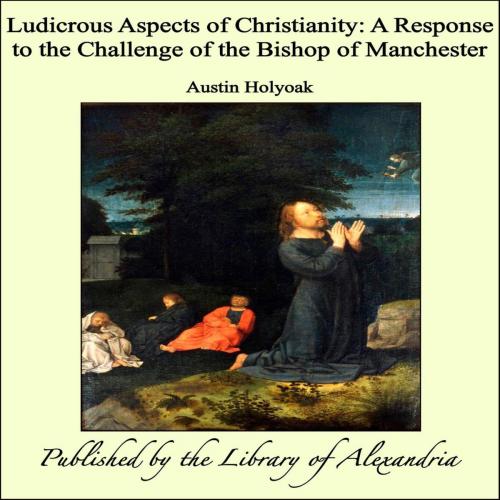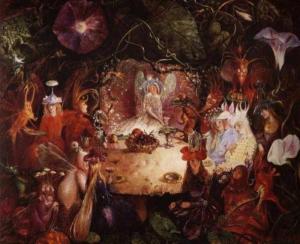Ludicrous Aspects of Christianity: A Response to the Challenge of the Bishop of Manchester
Nonfiction, Religion & Spirituality, New Age, History, Fiction & Literature| Author: | Austin Holyoak | ISBN: | 9781465561442 |
| Publisher: | Library of Alexandria | Publication: | July 29, 2009 |
| Imprint: | Library of Alexandria | Language: | English |
| Author: | Austin Holyoak |
| ISBN: | 9781465561442 |
| Publisher: | Library of Alexandria |
| Publication: | July 29, 2009 |
| Imprint: | Library of Alexandria |
| Language: | English |
The Bishop of Manchester, in a speech delivered by him in Oldham in August, 1870, is reported to have said that "he could defy anyone to try to caricature the work, the character, or the person of the Lord Jesus Christ." He no doubt felt confident in throwing out such a challenge, as the attempt would be considered so atrociously impious that few men could be found with courage enough to incur the odium of such an act. We confess that we have not the temerity to wound the sensitiveness of the devoutly religious. What may be deemed of the nature of caricature in the following remarks the reader is requested to regard as merely the spontaneous utterance of one who is keenly alive to the ludicrous, and who is not awed by the belief that the Bible is an infallible volume. We find the New Testament, when read without the deceptive spectacles of faith as amusing, as extravagant, and as contradictory in many places as most books. A system of religion, to be a moral guide to men, should be perfect in all its parts. It should not consist of a few precepts which might be followed under certain circumstances, the rest being made up of impossibilities and contradictions; but should be so comprehensive as to embrace all orders of men under all circumstances. And a divine exemplar to mankind, if such a being can be imagined, should possess every human virtue in perfection, and be absolutely without fault. We are told daily and hourly that Jesus Christ possesses these transcendent qualities, and is worthy of the homage and admiration of the world. We ask where this divine image is to be found, and are referred to the four Gospels in the New Testament. All that is there written was written by inspiration of God, and God therefore is the painter of the lineaments of his own Son. We will take it as such, and see what aspect Jesus presents when viewed in the light we are able to bring to bear upon his portrait. We shall follow a somewhat different plan to that adopted by M. Rénan. That great French writer has evidently gone to his task with the intention or anticipation of finding an almost perfect man, and he ends by believing he really sees one in Jesus. We have taken up the Gospels with the desire of finding what is actually there; and as it appears to us, so we will present it to the reader. We know that some will view the sayings and actions in a different light; but that is inevitable. No two persons ever see in the painted portrait of a friend or relative, precisely the same expression; yet they may be equally honest. Now we claim to be regarded as truthful in the following portraiture, though Jesus appears to us a very different man to what he appeared to M. Renan. Some may say we are flippant, but that we cannot help, though we may regret it. We must express ourselves in our own way, and we most be excused if we laugh at what seems ludicrous or absurd. We may be accused of a want of reverence, but we cannot feel reverence for what does not excite that feeling in us. These pages are not critical—they do not pretend to be learned—they do not seek to explain away anything on the score of "forgeries" or "interpolations." They are based upon the supposition that the Four Gospels are each and collectively true, and without contradiction. No attempt is made to reconcile contradictions by rejecting all that does not harmonise. The Churches do not do so—they cling to all within the two covers of the "sacred book," and of course take the responsibility
The Bishop of Manchester, in a speech delivered by him in Oldham in August, 1870, is reported to have said that "he could defy anyone to try to caricature the work, the character, or the person of the Lord Jesus Christ." He no doubt felt confident in throwing out such a challenge, as the attempt would be considered so atrociously impious that few men could be found with courage enough to incur the odium of such an act. We confess that we have not the temerity to wound the sensitiveness of the devoutly religious. What may be deemed of the nature of caricature in the following remarks the reader is requested to regard as merely the spontaneous utterance of one who is keenly alive to the ludicrous, and who is not awed by the belief that the Bible is an infallible volume. We find the New Testament, when read without the deceptive spectacles of faith as amusing, as extravagant, and as contradictory in many places as most books. A system of religion, to be a moral guide to men, should be perfect in all its parts. It should not consist of a few precepts which might be followed under certain circumstances, the rest being made up of impossibilities and contradictions; but should be so comprehensive as to embrace all orders of men under all circumstances. And a divine exemplar to mankind, if such a being can be imagined, should possess every human virtue in perfection, and be absolutely without fault. We are told daily and hourly that Jesus Christ possesses these transcendent qualities, and is worthy of the homage and admiration of the world. We ask where this divine image is to be found, and are referred to the four Gospels in the New Testament. All that is there written was written by inspiration of God, and God therefore is the painter of the lineaments of his own Son. We will take it as such, and see what aspect Jesus presents when viewed in the light we are able to bring to bear upon his portrait. We shall follow a somewhat different plan to that adopted by M. Rénan. That great French writer has evidently gone to his task with the intention or anticipation of finding an almost perfect man, and he ends by believing he really sees one in Jesus. We have taken up the Gospels with the desire of finding what is actually there; and as it appears to us, so we will present it to the reader. We know that some will view the sayings and actions in a different light; but that is inevitable. No two persons ever see in the painted portrait of a friend or relative, precisely the same expression; yet they may be equally honest. Now we claim to be regarded as truthful in the following portraiture, though Jesus appears to us a very different man to what he appeared to M. Renan. Some may say we are flippant, but that we cannot help, though we may regret it. We must express ourselves in our own way, and we most be excused if we laugh at what seems ludicrous or absurd. We may be accused of a want of reverence, but we cannot feel reverence for what does not excite that feeling in us. These pages are not critical—they do not pretend to be learned—they do not seek to explain away anything on the score of "forgeries" or "interpolations." They are based upon the supposition that the Four Gospels are each and collectively true, and without contradiction. No attempt is made to reconcile contradictions by rejecting all that does not harmonise. The Churches do not do so—they cling to all within the two covers of the "sacred book," and of course take the responsibility















